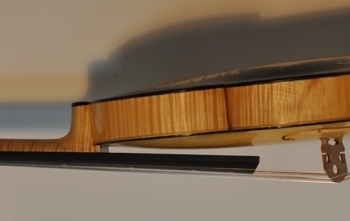Although it’s fun to develop innovative instruments based on my own ideas, it’s even better to work with demanding musicians on ambitious projects !
Nevertheless, I was quite sceptical when Egon Egemann, swiss crossover violinist from the group Mad Manouch, amang others) gave me a call to check whether I would make him an electroacosutic 5 string violin with two supplementary low strings, the viols’s c and the f below that.
That’s what he has bought a couple of month ago as a purely electric violin from Marc Wood violins.
Although I was seduced by the possibilities (those 6 strings cover nearly the whole register from cello to the violin), M. Egemann quickly felt limited by the unnatural and vibration-less sound of his new solidbody.
Having gained quite some experience in five strings, I was well aware about the difficulties and constraints: a resonance body too small to correctly amplify the low notes, low strings too short and at the same time too thick and with not enough tension, a more than delicate tonal balance, loss of power due to the mechanical constraint on the resonance body…
Fortunately, Mr Egemann agreed on a small viola rather than a violin size. That way, I could already gain a few cubic centimeters of volume for the body. With the same idea, I heightened the bass ribs even more than I usually do on the Neolin, and “pushed” the ribs virtually to the edges – which gave me 3 more spare mm in width and length. At the same time, the e-string had to sound full and beautiful, not acid, or screaming, or flat. So the treble side of the instrument is shortened to nearly violin dimensions.
To make the instrument resist mechanically, I raised thicknesses about 20% – I did not want to make a solid block, though ! I adopted the bracing from the Neolin, for extra stability and great response. The wood I used, top quality resonance wood from 1977, allowed me to retain a reasonable overall weigth.
Another big problem: The vibrating string length An e-string 3 cm longer than on a violin, wouldn’t have sounded great, while probably breaking quickly. On the other hand, an f string with only 36 cm vibrating string length would have been too loose and / or too thick.
So finally, I fit the bridge diagonally, with nearly 2 cm vibration string length difference between f and e. Even the accuracy of the fifth didn’t prove to be much of a problem with the right choice of strings.
A big thank you to Egon Egemann to have trusted me with this ambitous project. The result is up to his expactations !





















Add comment